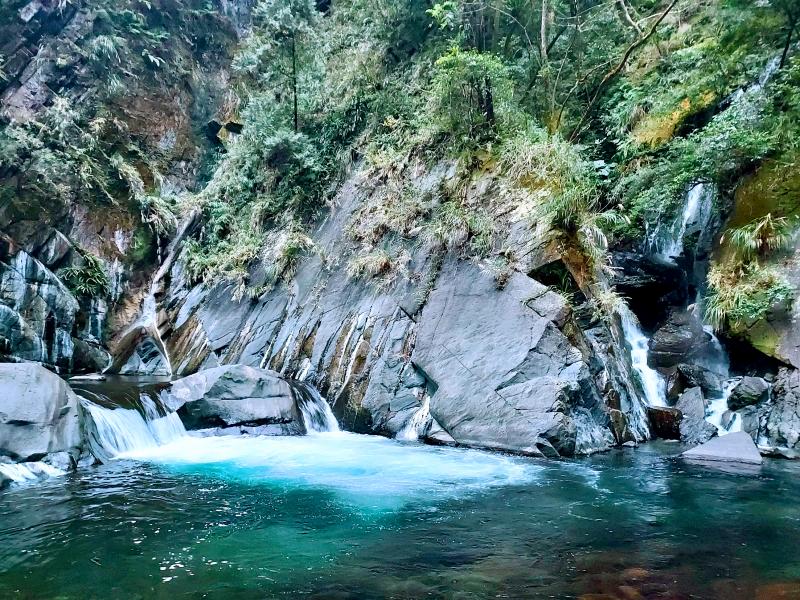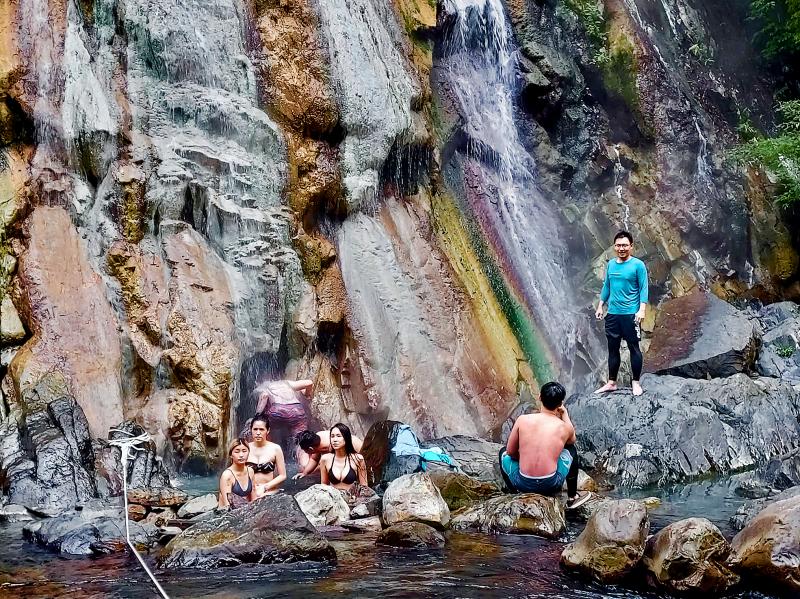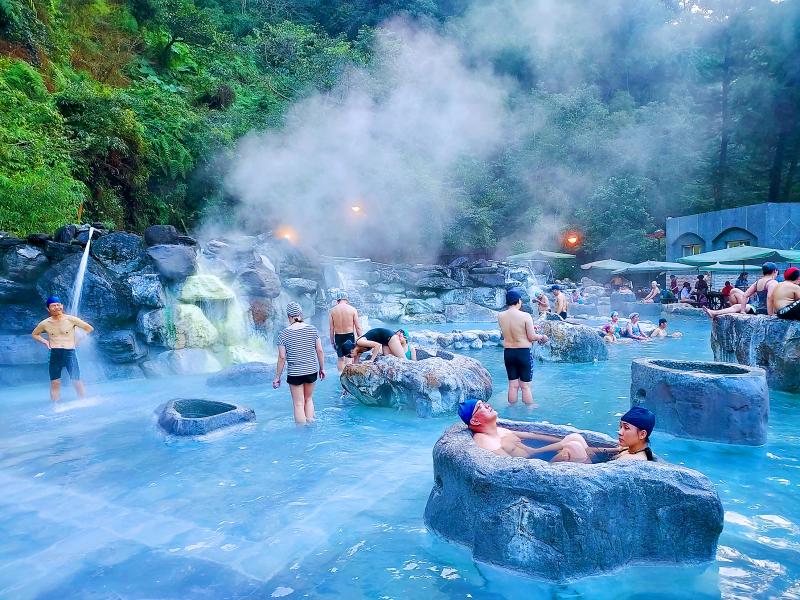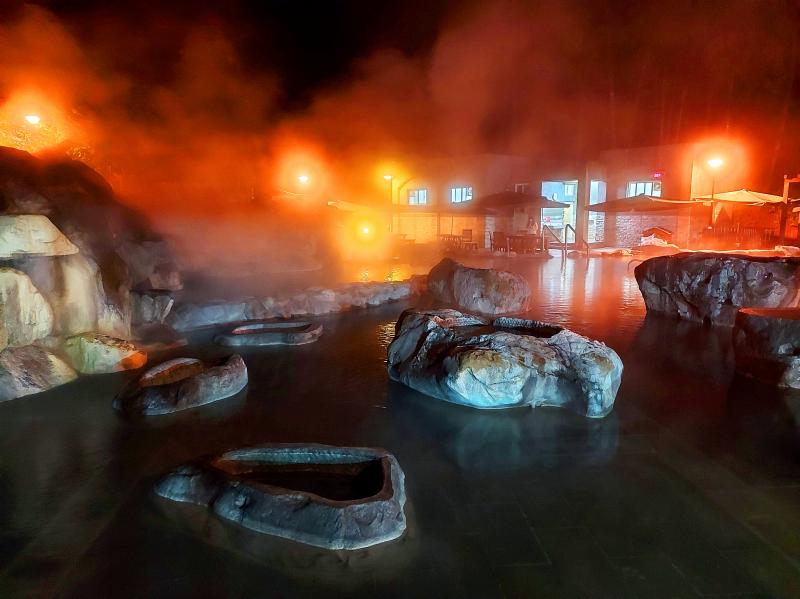Though there are no actively erupting volcanoes on Taiwan, evidence of the geothermal activity lurking just below the surface abounds. This takes the form of natural hot springs, with some developed into commercial attractions, but even more still wild, quietly awaiting those who are prepared to make the journey on foot. Further evidence comes in the form of a geyser, erupting regularly with geothermally heated water. All of these can be enjoyed as part of a cross-island journey from Taoyuan to Yilan on the Northern Cross-Island Highway (北橫公路).
The Northern Cross-Island Highway was completed in the 1960s, partially following a former police trail from the Japanese era. Though it is the lowest of the three major cross-island highways, it does not lack in stunning scenery. It is also the only one of the three that is open in its entirety at the moment, and given its proximity to the capital, makes for a great day trip from anywhere in northern Taiwan. An even better itinerary is to take two or three days and visit some of the geothermal wonders along the way.
SILENG WILD HOT SPRINGS

Photo: Tyler Cottenie
Just east of Sileng (四稜) — the site of a former police station where a smattering of buildings still remain — next to the 58.5K marker, is the trailhead for Sileng Hot Springs. There is a red sign here discouraging entry due to the “wet and slippery” trail, along with another smaller sign from the National Fire Agency encouraging hikers to download their 119 app for reporting emergencies. This alone is evidence of the great change in official attitudes toward outdoor recreation in recent years: previously, the attitude was not to discourage but to outright forbid.
The trail descends for half an hour through broadleaf forest, passing two flat areas that are often used as campsites; the latter can comfortably hold 20 to 30 people. Beyond the second campsite, the trail becomes much steeper. Scrambling over roots and rocky ledges is required, but there are ropes in place for assistance. Finally, just before reaching the riverbed, the hot springs area comes into view: a colorful cascade of hot water coursing down the cliff on the opposite bank into a collection of pools at the bottom.
Reaching the riverbed itself presents the penultimate technical challenge of the hike. There is a choice between a vertical mid-air descent by rope, or a vertical descent on a shaky homemade rope ladder. You did install that 119 app, right?

Photo: Tyler Cottenie
The riverbed area opposite the springs is wide, flat and rocky. Day hikers use this area for picnicking, while others choose to spend the night here, though the rocky ground would not make for comfortable tenting. The final hurdle to overcome is the river crossing, as the soaking pools are on the opposite side of the river. Fortunately, there are two ropes in place to hold onto as one crosses the river. Unfortunately, these ropes are fairly loose and the current is quite strong, so extreme care is still required to get across without falling and injuring one’s legs or feet on the rocks. Before crossing, the slope above the springs should be examined for any loose rocks that may be about to fall.
After crossing the river, one has a choice of about three different interconnected pools in which to soak. The pools have been designed so as to allow just enough river water in to maintain a comfortable temperature, approximately 39 degrees, without any obvious hot or cold spots. It is one of the best designed wild soaking areas this author has encountered in the whole country. As if that weren’t enough, there is also a small cave behind a curtain of falling hot water, just big enough for one person to enter and enjoy a natural steam room experience.
AN ATTRACTIVE DEVELOPED SPRING

Photo: Tyler Cottenie
After the Northern Cross-Island Highway descends to the bottom of the Lanyang River valley in Yilan County, it veers north-east toward Yilan City. A short drive in the other direction along Provincial Route 7 takes one to the entrance to the Taipingshan National Forest Recreation Area (太平山森林遊樂區), where two more geothermal attractions await: a developed hot spring site, and Taiwan’s only geyser.
First developed by the Japanese for the loggers working in the area, the Jioujhihze (鳩之澤) hot spring is a must-visit for anyone coming to the Taipingshan area. The current outdoor soaking pool’s atmosphere is hard to beat among Taiwan’s developed hot springs. The pool is artfully designed using natural stone, and the water glows an attractive blue color reminiscent of the Blue Lagoon in Iceland. There is a hot spring waterfall feature, and several raised stone tubs for individual soaking. The facility also offers a nude hot spring area and private soaking rooms.
Adjacent to the hot springs is an area where visitors can cook eggs or corn in hot spring water. Again, what sets this apart from similar facilities elsewhere in Taiwan is its attractive design. Bubbles introduced into the two stone cooking pools transform them into massive steaming geothermal cauldrons, enveloping visitors in clouds of fog, while the cooling pools for cooked eggs feature fun frog sculptures.

Photo: Tyler Cottenie
TAIWAN’S OLD FAITHFUL
Just east of here in the Tiangou River (天狗) valley is more evidence of the geothermal activity: the Tiangou Geyser. It can be accessed off of the main Taipingshan road, via a two-kilometer walk down a service road, or by tracing two kilometers upriver from the bridge on Provincial Route 7. The former starts at an unmarked intersection half a kilometer farther uphill from the turnoff to Jioujhihze, while the latter should only be attempted when the river level is low, as several crossings are necessary.
Visitors won’t have to wait long for the show, as the geyser erupts every 15 to 20 minutes, reaching heights of 10 meters. Close inspection between eruptions reveals a pipe in the ground here. In fact, the geyser is the result of past drilling by the Industrial Technology Research Institute, in an attempt to develop an economically viable geothermal energy source. The project was unsuccessful but the drilled well remains.
Further exploration along the Northern Cross-Island Highway and its branch roads will turn up even more wild hot springs, enough for more than a full season of weekend soaking. Fittingly, the final evidence of Taiwan’s geothermal underbelly is a dormant volcano, Turtle Island (龜山島), which comes into view off the coast of Yilan just as one reaches the end of the highway.

On Jan. 17, Beijing announced that it would allow residents of Shanghai and Fujian Province to visit Taiwan. The two sides are still working out the details. President William Lai (賴清德) has been promoting cross-strait tourism, perhaps to soften the People’s Republic of China’s (PRC) attitudes, perhaps as a sop to international and local opinion leaders. Likely the latter, since many observers understand that the twin drivers of cross-strait tourism — the belief that Chinese tourists will bring money into Taiwan, and the belief that tourism will create better relations — are both false. CHINESE TOURISM PIPE DREAM Back in July

Taiwan doesn’t have a lot of railways, but its network has plenty of history. The government-owned entity that last year became the Taiwan Railway Corp (TRC) has been operating trains since 1891. During the 1895-1945 period of Japanese rule, the colonial government made huge investments in rail infrastructure. The northern port city of Keelung was connected to Kaohsiung in the south. New lines appeared in Pingtung, Yilan and the Hualien-Taitung region. Railway enthusiasts exploring Taiwan will find plenty to amuse themselves. Taipei will soon gain its second rail-themed museum. Elsewhere there’s a number of endearing branch lines and rolling-stock collections, some

Could Taiwan’s democracy be at risk? There is a lot of apocalyptic commentary right now suggesting that this is the case, but it is always a conspiracy by the other guys — our side is firmly on the side of protecting democracy and always has been, unlike them! The situation is nowhere near that bleak — yet. The concern is that the power struggle between the opposition Chinese Nationalist Party (KMT) and their now effectively pan-blue allies the Taiwan People’s Party (TPP) and the ruling Democratic Progressive Party (DPP) intensifies to the point where democratic functions start to break down. Both

This was not supposed to be an election year. The local media is billing it as the “2025 great recall era” (2025大罷免時代) or the “2025 great recall wave” (2025大罷免潮), with many now just shortening it to “great recall.” As of this writing the number of campaigns that have submitted the requisite one percent of eligible voters signatures in legislative districts is 51 — 35 targeting Chinese Nationalist Party (KMT) caucus lawmakers and 16 targeting Democratic Progressive Party (DPP) lawmakers. The pan-green side has more as they started earlier. Many recall campaigns are billing themselves as “Winter Bluebirds” after the “Bluebird Action”